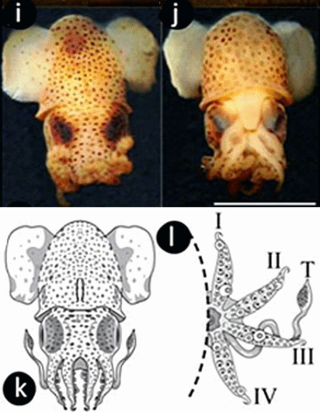Sepia dubia is a species of cuttlefish native to the southeastern Atlantic Ocean. It is known only from the type locality, where it was caught at a depth of 25 m.
Sepia hieronis is a species of cuttlefish native to the southeastern Atlantic Ocean and southwestern Indian Ocean, specifically southern Namibia, from approximately 27°S to Port Alfred, South Africa, and east Africa from 17°S to Kenya and Mozambique. It is also present in the Saya-de-Malha Bank. It lives at depths of between 43 and 500 m, although it is most abundant at 110 to 250 m depth.

Stoloteuthis leucoptera, also known as the butterfly bobtail squid, is a widespread species of bobtail squid. Its natural range covers the Atlantic Ocean, Mediterranean Sea, and southwestern Indian Ocean. It is distributed from the Gulf of St Lawrence to the Straits of Florida in the western Atlantic and in the Bay of Biscay in the eastern Atlantic. In the Mediterranean Sea, it is specifically found in the northern and southern Tyrrhenian Sea, Ligurian Sea, and off Gorgona Island. S. leucoptera has also been recorded from the Benguela Current off Namibia. There exist unverified records of specimens off eastern Tasmania.

Austrorossia mastigophora is a species of bobtail squid native to western, southern and eastern Africa, from Guinea and Somalia to the Cape of Good Hope. A doubtful record of this species exists from Chile. It lives at depths to approximately 640 m.

Sepiola rondeletii, also known as the dwarf bobtail, is a species of bobtail squid native to the northeastern Atlantic Ocean and the Mediterranean Sea, including the Strait of Sicily, Aegean Sea, Adriatic Sea, Sea of Marmara, and Levantine Sea. In the northeastern Atlantic, its natural range extends from the North Sea to Senegal. Females grow to 60 mm in mantle length, while males are not known to exceed 25 mm ML.

Semirossia tenera, also known as the lesser bobtail squid, is a widespread species of bobtail squid native to the northwest Atlantic Ocean. Its natural range covers the eastern coast of North America, from the northern Gulf of Maine to the Gulf of Mexico and the Caribbean Sea. S. tenera is possibly also present in the southwest Atlantic, specifically off the coasts of Suriname, French Guiana, Brazil, and Uruguay, although the latter records are questionable.

Rondeletiola minor, also known as the lentil bobtail, is a species of bobtail squid native to the eastern Atlantic Ocean and Mediterranean Sea. Its natural range covers the northwest of Spain, Portugal, and the eastern, central and western Mediterranean Sea to the southeastern Atlantic Benguela Current off Namibia.
Sepia mirabilis is a species of cuttlefish native to the western Indian Ocean. Specifically, it is present off Sokotra Island, and its natural range probably stretches to the east coast of Africa. It lives at depths to 50 m.

Sepia papillata is a species of cuttlefish native to the southeastern Atlantic Ocean and southwestern Indian Ocean. Its natural range stretches from Lüderitz Bay, South Africa, to the coast of KwaZulu-Natal off the Tugela and Umvoti Rivers. It is also present in Mascarene Ridge. It lives at depths of between 26 and 210 m.
Sepiola knudseni is a species of bobtail squid native to the eastern Atlantic Ocean, specifically northwest and west Africa, from the Canary Islands to the Gulf of Guinea. It lives on the inner continental shelf. S. knudseni lives at depths of 32 to 90 m.
Sepiola pfefferi is a species of bobtail squid native to the northeastern Atlantic Ocean. Specifically, it occurs on the continental shelf off the Faroe Islands and from southern Norway to Brittany in France. The depth range of this species is unknown.
Euprymna phenax is a species of bobtail squid native to the waters of the Indo-Pacific, off the Philippines and possibly in the East China Sea. The depth range of this species is unknown. It was originally collected at nightlight.
Rossia brachyura is a species of bobtail squid native to the tropical western Atlantic Ocean, specifically the Greater and Lesser Antilles.
Rossia bullisi, also known as the Gulf bobtail squid, is a species of bobtail squid native to the tropical western Atlantic Ocean, specifically the northern Gulf of Mexico and Straits of Florida.
Rossia megaptera, also known as the big-fin bobtail squid, is a species of bobtail squid native to the northwestern Atlantic Ocean, specifically Davis Strait, western Greenland, and off New York, in Hudson Canyon. It lives at depths from 179 to 1,536 m. It can grow up to 41 mm in mantle length.
Rossia mollicella is a species of bobtail squid native to the western Pacific Ocean, south from Sendai Bay, Japan. It occurs on the outer continental shelf and in the upper bathyal zone. R. mollicella lives at depths from 729 to 805 m.

Rossia palpebrosa, also known as the warty bobtail squid, is a species of bobtail squid native to the northern Atlantic Ocean.
Austrorossia enigmatica is a species of bobtail squid native to the southeastern Atlantic Ocean; it occurs off the coast of southern Africa from Namibia to Cape Province. It lives at depths from 276 to 400 m.

Semirossia patagonica is a species of bobtail squid native to the southwestern Atlantic Ocean and southeastern Pacific Ocean; it occurs around the southern part of South America and has been recorded from waters off Chile, Anegada Bay, Tierra del Fuego, Argentina, and the Falkland Islands.

Iridoteuthis iris is a species of bobtail squid native to the northern central Pacific Ocean; it occurs near the Hawaiian Islands off the southeast and northwest Hancock, Colahan, and Kammu seamounts. There exists a doubtful record from the Ceram Sea. Unlike most other bobtail squid, I. iris is pelagic and lives in the open ocean.










